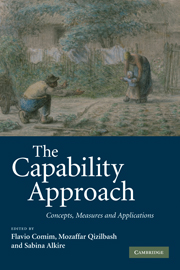Book contents
- Frontmatter
- Contents
- List of figures
- List of tables
- List of contributors
- List of acronyms
- Acknowledgements
- Introduction
- 1 Using the capability approach: prospective and evaluative analyses
- PART I Concepts
- PART II Measures
- PART III Applications
- 12 Democracy, decentralisation and access to basic services: an elaboration on Sen's capability approach
- 13 Reinforcing households' capabilities as a way to reduce vulnerability and prevent poverty in equitable terms
- 14 Capabilities over the lifecourse: at what age does poverty damage most?
- 15 Social policy and the ability to appear in public without shame: Some lessons from a food relief programme in Kinshasa
- 16 The capability approach and gendered education: some issues of operationalisation in the context of the HIV/AIDs epidemic in South Africa
- 17 Women and poverty in Mozambique: is there a gender bias in capabilities, employment conditions and living standards?
- 18 From the quantity to the quality of employment: an application of the capability approach to the Chilean labour market
- Index
- References
17 - Women and poverty in Mozambique: is there a gender bias in capabilities, employment conditions and living standards?
Published online by Cambridge University Press: 22 September 2009
- Frontmatter
- Contents
- List of figures
- List of tables
- List of contributors
- List of acronyms
- Acknowledgements
- Introduction
- 1 Using the capability approach: prospective and evaluative analyses
- PART I Concepts
- PART II Measures
- PART III Applications
- 12 Democracy, decentralisation and access to basic services: an elaboration on Sen's capability approach
- 13 Reinforcing households' capabilities as a way to reduce vulnerability and prevent poverty in equitable terms
- 14 Capabilities over the lifecourse: at what age does poverty damage most?
- 15 Social policy and the ability to appear in public without shame: Some lessons from a food relief programme in Kinshasa
- 16 The capability approach and gendered education: some issues of operationalisation in the context of the HIV/AIDs epidemic in South Africa
- 17 Women and poverty in Mozambique: is there a gender bias in capabilities, employment conditions and living standards?
- 18 From the quantity to the quality of employment: an application of the capability approach to the Chilean labour market
- Index
- References
Summary
Introduction
This chapter presents an analysis of the employment conditions and living standards in Mozambique with particular emphasis on women's conditions. A large strand of the literature has emphasised the existence of a gender bias in employment conditions and living standards, particularly in developing countries. Some have also argued about a supposed process of feminisation of poverty. In this chapter we try to address that issue by looking at the relationship between employment conditions, consumption expenditure, living conditions or ‘capabilities’, asset ownership and poverty of women in Mozambique. It is widely believed that women are poorer than men simply because they are women: they are discriminated against in the labour market (and so they earn less than men), they are discriminated against at home (and so they do not get the same education attainments as men), they are discriminated against in the family (they often have to work during the day and take care of their family at night). Although this opinion is relatively widespread and held true, it is not clear why it should be so, especially in a society that claims there are no gender barriers. Moreover, it is obviously important to understand what are the determinants of a greater poverty for women as opposed to men. In this chapter we will address the issue of whether women are actually discriminated against in the labour market, and, if so, if this leads to a larger percentage of poor among women as opposed to men.
- Type
- Chapter
- Information
- The Capability ApproachConcepts, Measures and Applications, pp. 510 - 560Publisher: Cambridge University PressPrint publication year: 2008



